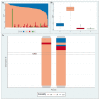Identification of Main Genetic Causes Responsible for Non-Syndromic Hearing Loss in a Peruvian Population
- PMID: 31370293
- PMCID: PMC6723399
- DOI: 10.3390/genes10080581
Identification of Main Genetic Causes Responsible for Non-Syndromic Hearing Loss in a Peruvian Population
Abstract
: Hearing loss (HL) is a common sensory disorder affecting over 5% of the global population. The etiology underlying HL includes congenital and acquired causes; genetic factors are the main cause in over 50% of congenital cases. Pathogenic variants in the GJB2 gene are a major cause of congenital non-syndromic hearing loss (NSHL), while their distribution is highly heterogeneous in different populations. To the best of our knowledge, there is no data regarding the genetic etiologies of HL in Peru. In this study, we screened 133 Peruvian families with NSHL living in Lima. We sequenced both exons of the GJB2 gene for all probands. Seven probands with familial NSHL that remained negative for GJB2 variants underwent whole genome sequencing (WGS). We identified biallelic pathogenic variants in GJB2 in 43 probands; seven were heterozygous for only one allele. The c.427C>T variant was the most common pathogenic variant followed by the c.35delG variant. WGS revealed three novel variants in MYO15A in two probands, one of them was predicted to affect splicing and the others produce a premature stop codon. The Peruvian population showed a complex profile for genetic variants in the GJB2 gene, this particular profile might be a consequence of the admixture history in Peru.
Keywords: GJB2; Peruvian; hearing loss; non-syndromic.
Conflict of interest statement
The authors declare no conflict of interest.
Figures


References
-
- Deafness and hearing loss. [(accessed on 30 October 2018)]; Available online: http://www.who.int/news-room/fact-sheets/detail/deafness-and-hearing-loss.
-
- Shearer A.E., Hildebrand M.S., Smith R.J. Hereditary Hearing Loss and Deafness Overview. In: Adam M.P., Ardinger H.H., Pagon R.A., Wallace S.E., Bean L.J., Stephens K., Amemiya A., editors. GeneReviews®. University of Washington; Seattle, WA, USA: 1993.
-
- Egilmez O.K., Kalcioglu M.T. Genetics of Nonsyndromic Congenital Hearing Loss. [(accessed on 30 October2018)]; Available online: https://www.hindawi.com/journals/scientifica/2016/7576064/ - PMC - PubMed
-
- Welcome to the Hereditary Hearing Loss Homepage | Hereditary Hearing Loss Homepage. [(accessed on 7 April 2019)]; Available online: https://hereditaryhearingloss.org/
Publication types
MeSH terms
Substances
Supplementary concepts
Grants and funding
LinkOut - more resources
Full Text Sources
Medical

